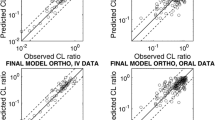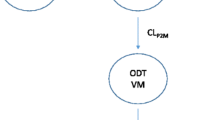Abstract
Background and Objectives
Current cytochrome P450 (CYP) 1A2 and 3A4 ontogeny profiles, which are derived mainly from in vitro studies and incorporated in paediatric physiologically based pharmacokinetic models, have been reported to under-predict the in vivo clearances of some model substrates in neonates and infants.
Method
We report ontogeny functions for these enzymes as paediatric to adult relative intrinsic clearance per mg of hepatic microsomal protein, based on the deconvolution of in vivo pharmacokinetic data and by accounting for the impact of known clinical condition on hepatic unbound intrinsic clearance for caffeine and theophylline as markers of CYP1A2 activity and for midazolam as a marker of CYP3A4 activity.
Results
The function for CYP1A2 describes an increase in relative intrinsic metabolic clearance from birth to 3 years followed by a decrease to adult values. The function for CYP3A4 describes a continuous rise in relative intrinsic metabolic clearance, reaching the adult value at about 1.3 years of age. The new models were validated by showing improved predictions of the systemic clearances of ropivacaine (major CYP1A2 substrate; minor CYP3A4 substrate) and alfentanil (major CYP3A4 substrate) compared with those using a previous ontogeny function based on in vitro data (alfentanil: mean squared prediction error 3.0 vs. 6.8; ropivacaine: mean squared prediction error 2.3 vs.14.2).
Conclusions
When implementing enzyme ontogeny functions, it is important to consider potential confounding factors (e.g. disease) that may affect the physiological conditions of the patient and, hence, the prediction of net in vivo clearance.








Similar content being viewed by others
References
Barrett JS, Della Casa Alberighi O, Laer S, Meibohm B. Physiologically based pharmacokinetic (PBPK) modeling in children. Clin Pharmacol Ther. 2012;92(1):40–9.
Huang SM, Abernethy DR, Wang Y, Zhao P, Zineh I. The utility of modeling and simulation in drug development and regulatory review. J Pharm Sci. 2013;102(9):2912–23.
Leong R, Vieira ML, Zhao P, Mulugeta Y, Lee CS, Huang SM, et al. Regulatory experience with physiologically based pharmacokinetic modeling for pediatric drug trials. Clin Pharmacol Ther. 2012;91(5):926–31.
Johnson TN, Rostami-Hodjegan A, Tucker GT. Prediction of the clearance of eleven drugs and associated variability in neonates, infants and children. Clin Pharmacokinet. 2006;45(9):931–56.
Bjorkman S. Prediction of drug disposition in infants and children by means of physiologically based pharmacokinetic (PBPK) modelling: theophylline and midazolam as model drugs. Br J Clin Pharmacol. 2005;59(6):691–704.
Edginton AN, Schmitt W, Voith B, Willmann S. A mechanistic approach for the scaling of clearance in children. Clin Pharmacokinet. 2006;45(7):683–704.
Tsamandouras N, Rostami-Hodjegan A, Aarons L. Combining the “bottom-up” and “top-down” approaches in pharmacokinetic modelling: fitting PBPK models to observed clinical data. Br J Clin Pharmacol. Epub 2013 Sep 3.
Anderson B, Holford N. Evaluation of a morphine maturation model for the prediction of morphine clearance in children [letter]. Br J Clin Pharmacol. 2011;72(3):518–20 (author reply 21–3).
Anderson BJ, Holford NH. Mechanistic basis of using body size and maturation to predict clearance in humans. Drug Metab Pharmacokinet. 2009;24(1):25–36.
Anderson BJ, Larsson P. A maturation model for midazolam clearance. Paediatr Anaesth. 2011;21(3):302–8.
Ince I, de Wildt SN, Wang C, Peeters MY, Burggraaf J, Jacqz-Aigrain E, et al. A novel maturation function for clearance of the cytochrome P450 3A substrate midazolam from preterm neonates to adults. Clin Pharmacokinet. 2013;52(7):555–65.
Anderson BJ, Woollard GA, Holford NH. A model for size and age changes in the pharmacokinetics of paracetamol in neonates, infants and children. Br J Clin Pharmacol. 2000;50(2):125–34.
Ha HR, Chen J, Freiburghaus AU, Follath F. Metabolism of theophylline by cDNA-expressed human cytochromes P-450. Br J Clin Pharmacol. 1995;39(3):321–6.
Ha HR, Chen J, Krahenbuhl S, Follath F. Biotransformation of caffeine by cDNA-expressed human cytochromes P-450. Eur J Clin Pharmacol. 1996;49(4):309–15.
Shimada T, Yamazaki H, Mimura M, Inui Y, Guengerich FP. Interindividual variations in human liver cytochrome P-450 enzymes involved in the oxidation of drugs, carcinogens and toxic chemicals: studies with liver microsomes of 30 Japanese and 30 Caucasians. J Pharmacol Exp Ther. 1994;270(1):414–23.
Sonnier M, Cresteil T. Delayed ontogenesis of CYP1A2 in the human liver. Eur J Biochem. 1998;251(3):893–8.
Tateishi T, Nakura H, Asoh M, Watanabe M, Tanaka M, Kumai T, et al. A comparison of hepatic cytochrome P450 protein expression between infancy and postinfancy. Life Sci. 1997;61(26):2567–74.
Treluyer JM, Bowers G, Cazali N, Sonnier M, Rey E, Pons G, et al. Oxidative metabolism of amprenavir in the human liver. Effect of the CYP3A maturation. Drug Metab Dispos. 2003;31(3):275–81.
Hines RN. Ontogeny of human hepatic cytochromes P450. J Biochem Mol Toxicol. 2007;21(4):169–75.
Lacroix D, Sonnier M, Moncion A, Cheron G, Cresteil T. Expression of CYP3A in the human liver-evidence that the shift between CYP3A7 and CYP3A4 occurs immediately after birth. Eur J Biochem. 1997;247(2):625–34.
Stevens JC, Hines RN, Gu C, Koukouritaki SB, Manro JR, Tandler PJ, et al. Developmental expression of the major human hepatic CYP3A enzymes. J Pharmacol Exp Ther. 2003;307(2):573–82.
Morse M, Cassels D, Schlutz F. Blood volumes of normal children. Am J Physiol. 1947;151:448–58.
Rhodin MM, Anderson BJ, Peters AM, Coulthard MG, Wilkins B, Cole M, et al. Human renal function maturation: a quantitative description using weight and postmenstrual age. Pediatr Nephrol. 2009;24(1):67–76.
Alcorn J, McNamara PJ. Ontogeny of hepatic and renal systemic clearance pathways in infants: part II. Clin Pharmacokinet. 2002;41(13):1077–94.
Cartlidge PH, Rutter N. Serum albumin concentrations and oedema in the newborn. Arch Dis Child. 1986;61(7):657–60.
Reading RF, Ellis R, Fleetwood A. Plasma albumin and total protein in preterm babies from birth to eight weeks. Early Hum Dev. 1990;22(2):81–7.
Laudy JA, Janssen MM, Struyk PC, Stijnen T, Wallenburg HC, Wladimiroff JW. Fetal liver volume measurement by three-dimensional ultrasonography: a preliminary study. Ultrasound Obstet Gynecol. 1998;12(2):93–6.
Barter ZE, Chowdry JE, Harlow JR, Snawder JE, Lipscomb JC, Rostami-Hodjegan A. Covariation of human microsomal protein per gram of liver with age: absence of influence of operator and sample storage may justify interlaboratory data pooling. Drug Metab Dispos. 2008;36(12):2405–9.
Arlander E, Ekstrom G, Alm C, Carrillo JA, Bielenstein M, Bottiger Y, et al. Metabolism of ropivacaine in humans is mediated by CYP1A2 and to a minor extent by CYP3A4: an interaction study with fluvoxamine and ketoconazole as in vivo inhibitors. Clin Pharmacol Ther. 1998;64(5):484–91.
Kharasch ED, Russell M, Mautz D, Thummel KE, Kunze KL, Bowdle A, et al. The role of cytochrome P450 3A4 in alfentanil clearance. Implications for interindividual variability in disposition and perioperative drug interactions. Anesthesiology. 1997;87(1):36–50.
Durward A, Mayer A, Skellett S, Taylor D, Hanna S, Tibby SM, et al. Hypoalbuminaemia in critically ill children: incidence, prognosis, and influence on the anion gap. Arch Dis Child. 2003;88(5):419–22.
Horowitz IN, Tai K. Hypoalbuminemia in critically ill children. Arch Pediatr Adolesc Med. 2007;161(11):1048–52.
Ulldemolins M, Roberts JA, Rello J, Paterson DL, Lipman J. The effects of hypoalbuminaemia on optimizing antibacterial dosing in critically ill patients. Clin Pharmacokinet. 2011;50(2):99–110.
Salive ME, Cornoni-Huntley J, Phillips CL, Guralnik JM, Cohen HJ, Ostfeld AM, et al. Serum albumin in older persons: relationship with age and health status. J Clin Epidemiol. 1992;45(3):213–21.
Vincent JL, Dubois MJ, Navickis RJ, Wilkes MM. Hypoalbuminemia in acute illness: is there a rationale for intervention? A meta-analysis of cohort studies and controlled trials. Ann Surg. 2003;237(3):319–34.
Bonnet F, Richard C, Glaser P, Lafay M, Guesde R. Changes in hepatic flow induced by continuous positive pressure ventilation in critically ill patients. Crit Care Med. 1982;10(11):703–5.
Bamat N, Millar D, Suh S, Kirpalani H. Positive end expiratory pressure for preterm infants requiring conventional mechanical ventilation for respiratory distress syndrome or bronchopulmonary dysplasia. Cochrane Database Syst Rev. 2012;1:CD004500.
Gabrielsson J, Weiner D. Pharmacokinetic & pharmacodynamic data analysis: concepts and applications. 4th ed. Sweden: Swedish Pharmaceutical Press; 2007.
Sheiner LB, Beal SL. Some suggestions for measuring predictive performance. J Pharmacokinet Biopharm. 1981;9(4):503–12.
Ekstrom G, Gunnarsson UB. Ropivacaine, a new amide-type local anesthetic agent, is metabolized by cytochromes P450 1A and 3A in human liver microsomes. Drug Metab Dispos. 1996;24(9):955–61.
DrugBank. Ropivacaine. http://www.drugbank.ca/drugs/DB00296#properties. Accessed 19 Dec 2013.
Machavaram KK, Almond LM, Rostami-Hodjegan A, Gardner I, Jamei M, Tay S, et al. A physiologically-based pharmacokinetic modelling approach to predict disease-drug interactions: suppression of CYP3A by IL-6. Clin Pharmacol Ther. 2013;94(2):260–8.
Azam YJ, Machavaram KK, Rostami-Hodjegan A. The modulating effect of endogenous substances on drug metabolising enzymes and implications for inter-individual variability and in vitro-in vivo extrapolation to predict disease-drug interactions. Curr Drug Metab. In Press.
Williams JA, Ring BJ, Cantrell VE, Jones DR, Eckstein J, Ruterbories K, et al. Comparative metabolic capabilities of CYP3A4, CYP3A5, and CYP3A7. Drug Metab Dispos. 2002;30(8):883–91.
Le Guennec JC, Billon B. Delay in caffeine elimination in breast-fed infants. Pediatrics. 1987;79(2):264–8.
Lambert GH, Schoeller DA, Kotake AN, Flores C, Hay D. The effect of age, gender, and sexual maturation on the caffeine breath test. Dev Pharmacol Ther. 1986;9(6):375–88.
Levitsky LL, Schoeller DA, Lambert GH, Edidin DV. Effect of growth hormone therapy in growth hormone-deficient children on cytochrome P-450-dependent 3-N-demethylation of caffeine as measured by the caffeine 13CO2 breath test. Dev Pharmacol Ther. 1989;12(2):90–5.
Peeters MY, Prins SA, Knibbe CA, Dejongh J, Mathot RA, Warris C, et al. Pharmacokinetics and pharmacodynamics of midazolam and metabolites in nonventilated infants after craniofacial surgery. Anesthesiology. 2006;105(6):1135–46.
Acknowledgment
The authors wish to thank Eleanor Savill for her assistance in preparing the manuscript for submission.
Conflict of interest
Farzaneh Salem, Khaled Abduljalil and Trevor Johnson are employees of Simcyp Limited (a Certara company). Geoffrey Tucker is an employee of Simcyp Limited (a Certara company) and an Emeritus Professor of the University of Sheffield. Amin Rostami-Hodjegan is an employee of the University of Manchester seconded part-time to Simcyp Limited (a Certara company). Simcyp’s research is funded by a consortium of pharma companies.
Author information
Authors and Affiliations
Corresponding author
Electronic supplementary material
Below is the link to the electronic supplementary material.
Rights and permissions
About this article
Cite this article
Salem, F., Johnson, T.N., Abduljalil, K. et al. A Re-evaluation and Validation of Ontogeny Functions for Cytochrome P450 1A2 and 3A4 Based on In Vivo Data. Clin Pharmacokinet 53, 625–636 (2014). https://doi.org/10.1007/s40262-014-0140-7
Published:
Issue Date:
DOI: https://doi.org/10.1007/s40262-014-0140-7




